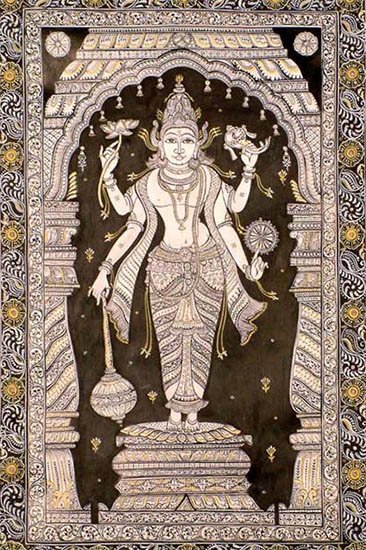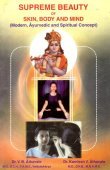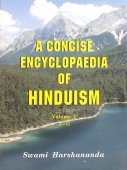Humour, Humor: 3 definitions
Introduction:
Humour means something in Hinduism, Sanskrit. If you want to know the exact meaning, history, etymology or English translation of this term then check out the descriptions on this page. Add your comment or reference to a book if you want to contribute to this summary article.
In Hinduism
Gitashastra (science of music)
Source: Shodhganga: Elements of Art and Architecture in the Trtiyakhanda of the Visnudharmottarapurana (gita)The Humour Sentiment (in Sanskrit: hāsya-rasa) refers to one of the nine kinds of Sentiment (rasa) in Indian classical Music. They have an inherent relationship with the svaras (“musical notes”).—There are nine kinds of sentiments: [e.g., Humour (hāsya)]. In the Nāṭyaśāstra some particular svaras are determined for the delineation of some specific sentiments. In the Nāṭyaśāstra it is accepted that—the notes madhyama and pañcama are used to delineate the sentiments of hāsya and śṛṅgāra.
Gitashastra (गीतशास्त्र, gītaśāstra) refers to the ancient Indian science of Music (gita or samgita), which is traditionally divided in Vocal music, Instrumental music and Dance (under the jurisdiction of music). The different elements and technical terms are explained in a wide range of (often Sanskrit) literature.
Natyashastra (theatrics and dramaturgy)
Source: Shodhganga: Elements of Art and Architecture in the Trtiyakhanda of the Visnudharmottarapurana (natya)The Sentiment of Humour is denoted by the Sanskrit term Hāsya-rasa, which represents one of the nine kinds of Rasa (“soul of Drama”), according to the Viṣṇudharmottarapurāṇa, an ancient Sanskrit text which (being encyclopedic in nature) deals with a variety of cultural topics such as arts, architecture, music, grammar and astronomy.—The Viṣṇudharmottarapurāṇa says that hāsyarasa is generated from some irrelevant or funny conversations or attires which bring humour to the viewers’ mind and the viewers start laughing. The Nāṭyaśāstra speaks that, the comic sentiment is created through the determinants like deformed dress or ornaments, impudence, greediness, quarrel, use of irrelevant and inappropriate words etc.

Natyashastra (नाट्यशास्त्र, nāṭyaśāstra) refers to both the ancient Indian tradition (shastra) of performing arts, (natya—theatrics, drama, dance, music), as well as the name of a Sanskrit work dealing with these subjects. It also teaches the rules for composing Dramatic plays (nataka), construction and performance of Theater, and Poetic works (kavya).
Shilpashastra (iconography)
Source: Shodhganga: Elements of Art and Architecture in the Trtiyakhanda of the Visnudharmottarapurana (shilpa)Humour refers to one of the Nine Sentiments (citrarasa) in ancient Indian Painting (citra), according to the Viṣṇudharmottarapurāṇa, an ancient Sanskrit text which (being encyclopedic in nature) deals with a variety of cultural topics such as arts, architecture, music, grammar and astronomy.—Painting is a medium of showing the inner feelings and emotions of a painter which can strikes the inherent sentiments of connoisseur’s mind [e.g., the sentiment of humour (hāsya)]. [...] According to the Viṣṇudharmottarapurāṇa, hāsya i.e., the sentiment of humour is reflected through the Painting of a person who is hunchback, dwarfish and somewhat deformed in appearance.

Shilpashastra (शिल्पशास्त्र, śilpaśāstra) represents the ancient Indian science (shastra) of creative arts (shilpa) such as sculpture, iconography and painting. Closely related to Vastushastra (architecture), they often share the same literature.
See also (Relevant definitions)
Ends with: Ill Humour.
Full-text (+519): Tridosha, Kapha, Samnipata, Shleshman, Pitta, Balasa, Dhatu, Sannipatika, Vatika, Vatajvara, Dosha, Pittavayu, Vayu, Hasyarasa, Pittakshobha, Hasya, Pittaprakopa, Snehabhu, Palagni, Khushamarji.
Relevant text
Search found 132 books and stories containing Humour, Humor; (plurals include: Humours, Humors). You can also click to the full overview containing English textual excerpts. Below are direct links for the most relevant articles:
Bhesajjakkhandhaka (Chapter on Medicine) (by Hin-tak Sik)
Internal Medicine (c): Disorders of Humours/Elements < [Chapter 5 - Diseases and Treatments in the Chapter on Medicine]
Internal Medicine (g): Jaundice < [Chapter 5 - Diseases and Treatments in the Chapter on Medicine]
Internal Medicine (e): Gastrointestinal Disturbances < [Chapter 5 - Diseases and Treatments in the Chapter on Medicine]
Charaka Samhita (English translation) (by Shree Gulabkunverba Ayurvedic Society)
Chapter 17 - The diseases of the head (shiroroga) and of the heart (hridroga) < [Sutrasthana (Sutra Sthana) — General Principles]
Chapter 1 - The Measure of Tastes (rasa-vimana) < [Vimanasthana (Vimana Sthana) — Section on Measure]
Chapter 6 - Nosology (roganika-vimana) < [Vimanasthana (Vimana Sthana) — Section on Measure]
Sushruta Samhita, volume 1: Sutrasthana (by Kaviraj Kunja Lal Bhishagratna)
Chapter XXI - Questions concerning wounds
Chapter XXIV - Knowledge of diseases
Dasarupaka (critical study) (by Anuru Ranjan Mishra)
Part 14 - Conclusion < [Chapter 3 - Prahasana (critical study)]
Part 3-6 - Prahasana rules < [Chapter 3 - Prahasana (critical study)]
Part 8 - Style (Vṛtti) of the Prahasana < [Chapter 3 - Prahasana (critical study)]
Mahabharata (English) (by Kisari Mohan Ganguli)
Section XII < [Ashvamedhika Parva]
Section CLXXXV < [Mokshadharma Parva]
Section XV < [Kicaka-badha Parva]
Yoga Vasistha [English], Volume 1-4 (by Vihari-Lala Mitra)
Chapter CXLV - Description of the waking, dreaming and sleeping states < [Book VII - Nirvana prakarana part 2 (nirvana prakarana)]
Chapter XXIV - Investigation of the living principle < [Book VI - Nirvana prakarana part 1 (nirvana prakarana)]
Chapter XCII - Description of the current air, as the universal spirit < [Book VII - Nirvana prakarana part 2 (nirvana prakarana)]
Related products

